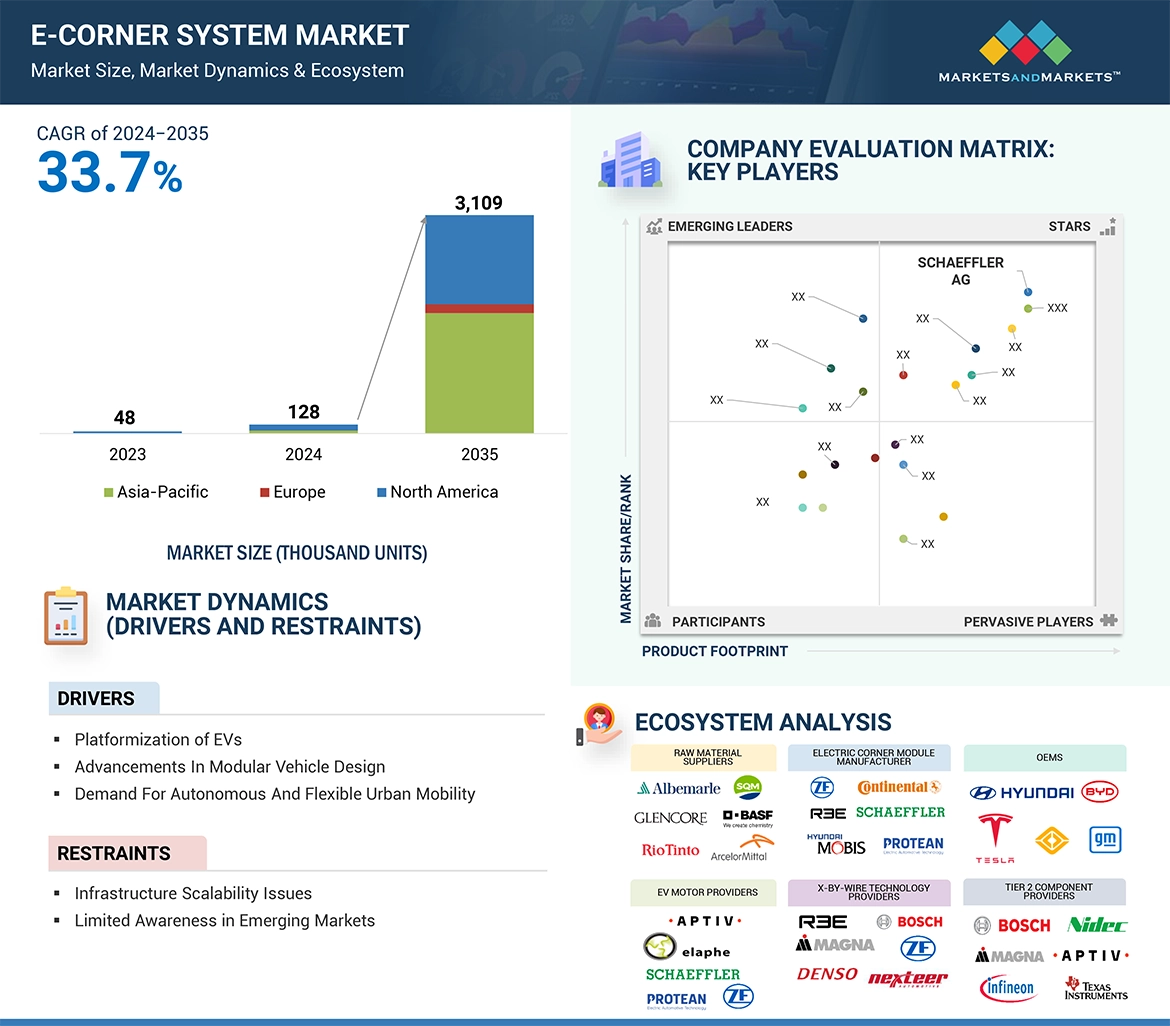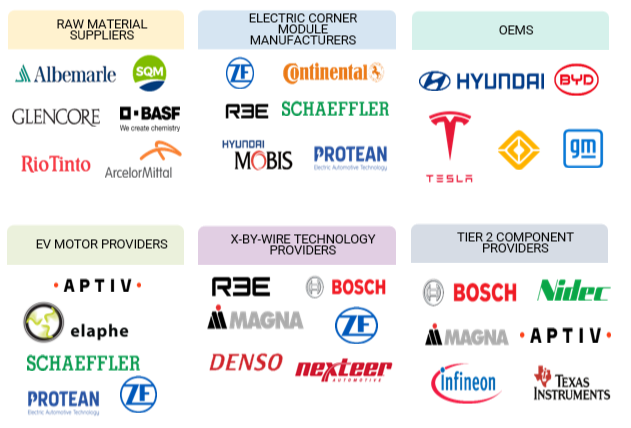
1 はじめに 17
1.1 調査目的 17
1.2 市場の定義 17
1.2.1 包含と除外 18
1.3 市場範囲 19
1.3.1 対象市場 19
1.3.2 考慮した年 19
1.4 通貨 20
1.5 単位の検討 20
1.6 利害関係者 20
2 調査方法 21
2.1 調査データ 21
2.1.1 二次データ 22
2.1.1.1 主な二次資料 23
2.1.1.2 二次資料からの主要データ 24
2.1.2 一次データ 24
2.1.2.1 一次インタビュー参加者 25
2.1.2.2 主要な業界インサイト 25
2.1.2.3 一次インタビューの内訳 26
2.1.2.4 一次インタビュー参加者リスト 26
2.2 市場規模推計方法 26
2.2.1 ボトムアップアプローチ 28
2.3 市場の内訳とデータの三角測量 29
2.4 要因分析 30
2.5 調査の前提 30
2.6 調査の限界 31
3 エグゼクティブサマリー 32
4 技術分析 37
4.1 E コーナーシステムと統合パワートレイン技術の技術ロードマップ 37
4.1.1 完全統合電気コーナーモジュール/統合パワートレイン 38
4.1.1.1 インホイールモーター(IWM) 38
4.1.1.2 トライモーター/クアッドモーター構成(ニアホイールモーター) 38
4.1.1.3 ドライブ・ブレーキ・ユニット 38
4.1.2 セミアクティブサスペンションモジュールシステム 39
4.1.2.1 モジュール式サスペンション設計 39
4.1.2.2 調整可能エアスプリング 39
4.1.3 ステア・バイ・ワイヤ・モジュール/ステアリング・メカニズム 39
4.1.3.1 ステアバイワイヤシステム 39
4.1.3.2 統合制御ユニット 39
4.1.4 制動・推進モジュール/制動技術 39
4.1.4.1 ドライ・ブレーキ・システム 39
4.1.4.2 電気機械式ブレーキ 40
4.1.5 センサーの統合 40
4.1.5.1 先進センサーシステム 40
4.2 Eコーナーシステムのコンポーネント 40
4.2.1 x-バイ-ワイヤ 42
4.2.1.1 アクチュエーター 42
4.2.1.2 センサー 42
4.2.1.3 制御ユニット 42
4.2.1.4 通信ネットワーク 43
4.2.1.5 機械部品 43
4.2.1.6 電源 43
4.2.1.7 安全機構 43
4.2.1.8 ユーザーインターフェース 43
4.2.2 縦方向運動による 43
4.2.2.1 推進力 43
4.2.2.1.1 インホイールモータの特性 43
4.2.2.1.2 ドライブ・バイ・ワイヤ 44
4.2.2.1.3 インホイールモータ用電気機械 44
4.2.2.2 ブレーキ 44
4.2.2.2.1 インホイールモータによる回生ブレーキ 44
4.2.2.2.2 ブレーキバイワイヤ 45
4.2.2.2.3 電気機械式ディスクブレーキ 45
4.2.3 垂直運動によるもの 45
4.2.3.1 サスペンションアクチュエータ 45
4.2.3.2 動力源 45
4.2.3.3 制御ユニット 45
4.2.3.4 センサー 45
4.2.3.5 ダンパーとスプリング 46
4.2.3.6 エネルギー貯蔵システム 46
4.2.3.7 油圧コンポーネント(ハイブリッド) 46
4.2.3.8 機械的リンケージ 46
4.2.3.9 パワーエレクトロニクス・コンバータ 46
4.3 ハイパーカーにおけるEコーナーシステム技術 46
4.4 Eコーナーシステムの採用と費用便益分析 47
4.4.1 電動コーナーモジュール採用の主な影響 48
4.4.1.1 効率と性能の向上 48
4.4.1.2 省スペースと軽量化 48
4.4.1.3 製造と組み立ての簡素化 48
4.4.1.4 初期投資の増加 49
4.4.1.5 メンテナンスと信頼性への懸念 49
4.4.2 電動コーナーモジュール採用の費用便益分析 49
4.4.2.1 コスト分析 50
4.4.2.1.1 初期費用 50
4.4.2.1.2 運用コスト 50
4.4.2.2 便益分析 50
4.4.2.2.1 長期的節約 50
4.4.2.2.2 車両価値の向上 50
4.5 エコシステム分析 51
4.5.1 OEMS 52
4.5.2 コンポーネントメーカー 53
4.5.3 eコーナーモジュールメーカー 54
4.5.4 原材料サプライヤー 56
4.6 ケーススタディとプロトタイプ分析 57
4.6.1 電動コーナーモジュールのプロトタイプとサブシステムの進化 57
4.6.2 OEM戦略 58
4.6.2.1 BMW 58
4.6.2.2 フォルクスワーゲン(VW) 59
4.6.2.3 メルセデス・ベンツ 61
4.6.2.4 テスラ 62
4.6.2.5 ヒュンダイ 63
4.6.2.6 リビアン 64
4.6.2.7 ABボルボ 67
4.6.2.8 ファラデー・フューチャー 68
4.6.3 プロトタイプ分析 70
4.6.3.1 トヨタeパレット 70
4.6.3.1.1 ePaletteデザインの概要 70
4.6.3.1.2 トヨタePaletteにおける電動コーナーモジュールの機能 70
4.6.3.1.2.1 独立ホイール制御 70
4.6.3.1.2.2 アクティブサスペンションシステム 71
4.6.3.1.2.3 先進センサー技術 71
4.6.3.1.2.4 自動運転システム 71
4.6.3.1.2.5 安全のための冗長システム 71
4.6.3.2 シェフラー・ムーバー 72
4.6.3.2.1 シェフラー・ムーバーの設計概要 73
4.6.3.2.2 シェフラー・ムーバーの電動コーナーモジュールの機能 74
4.6.3.2.2.1 ホイールハブ駆動システム 74
4.6.3.2.2 シェフラーインテリジェントコーナーモジュール 74
4.6.3.3 リンスピードのコンセプトカー 75
4.6.3.3.1 リンスピードのコンセプトカーデザインの概要 76
4.6.3.3.2 電動コーナーモジュールの機能性
機能 77
4.6.3.3.2.1 オアシスにおける電動コーナーモジュールの機能 77
4.6.3.3.2.2 Snapにおける電動コーナーモジュールの機能 77
4.6.3.3.2.3 MicroSnapにおける電動コーナーモジュールの機能 78
4.6.3.3.2.4 MetroSnapにおける電気コーナーモジュールの機能 79
4.6.3.3.2.5 CitySnap における電気コーナーモジュールの機能 79
4.6.3.4 REE P7 EVプラットフォーム 80
4.6.3.4.1 REE P7 EVプラットフォームの設計概要 80
4.6.3.4.1.1 主な設計機能 80
4.6.3.4.2 REE P7プラットフォームにおける電気コーナーモジュールの機能 81
4.6.3.4.2.1 主要機能 81
4.6.3.5 Hino FlatFormer 82
4.6.3.5.1 Hino FlatFormer 設計の概要 82
4.6.3.5.2 Hino FlatFormer における電動コーナーモジュールの機能 83
4.6.3.5.2.1 インホイールモーターの統合 83
4.6.3.5.2.2 ステアリングシステム 84
4.6.3.5.2.3 ブレーキバイワイヤシステム 84
4.6.3.5.2.4 サスペンションシステム 84
4.6.3.5.2.5 アクティブ・ノイズ、振動、ハーシュネス(NVH)マネジメント 84
4.6.3.5.2.6 AIデータユニット 84
4.6.3.5.2.7 パワーマネジメント 85
4.6.3.5.2.8 スリップ検知とトラクションコントロール 85
5 電子コーナー市場の展望(地域別) 86
5.1 はじめに
5.2 アジア太平洋地域 88
5.2.1 乗用車用高級電気自動車における先進運転機能に対する需要の高まりが成長を牽引 88
5.3 ヨーロッパ 90
5.3.1 Eコーナーモジュール技術の地域開発と高級電気自動車への搭載計画
高級電気自動車とシャトルへの搭載計画が需要を牽引 90
5.4 北米 91
5.4.1 主要自動車メーカーによる電気乗用車と小型商用車分野での早期採用が
および小型商用車分野での主要自動車メーカーによる早期採用が需要を牽引 91
6 Eコーナー市場の展望、モーター構成別 94
6.1 導入 94
6.2 3モーター構成 95
6.2.1 高いインパクトで費用対効果の高いコーナリングソリューションへの需要が市場を牽引 95
6.3 クアッドモーター構成 96
6.3.1 ハイエンドの高級電気自動車やロボットタクシーにおける高出力、高度なステアリング 制御、操縦性の向上に対する需要が市場を牽引 96
7 e コーナー市場の展望(車両タイプ別) 98
7.1 導入 98
7.2 乗用車 99
7.2.1 高度な運転機能に対する需要が市場を牽引 99
7.3 小型商用車 100
7.3.1 複雑な地形における高級ピックアップへの需要が市場を牽引 100
8 企業プロファイル 102
SCHAEFFLER AG
PROTEAN
HYUNDAI MOBIS
REE
CONTINENTAL AG
ELAPHE LTD
BENTELER INTERNATIONAL AG
ZF FRIEDRICHSHAFEN AG
ZEEKR
ASPARK CO. LTD
LOTUS
BUGATTI RIMAC D.O.O.
NIO
CANOO
9 マーケットサンダーによる推奨 167
9.1 はじめに 167
9.2 OEMと技術プロバイダーのパートナーシップ 168
9.3 レアアース代替の電子モーター 168
9.4 eコーナーモジュールの普及を加速する容易なプラットフォーム統合 168
9.5 自動車のサイバーセキュリティへの投資の増加 168
9.6 相互運用性と標準化の促進 169
9.7 スマートな製品設計とプロトタイプの採用 169
9.8 無線アップデートによるオンデマンドでの革新的機能の提供 169
9.9 シャトルやロボットタクシー事業者との提携 170
10 付録 171
10.1 業界専門家の主な洞察 171
10.2 ディスカッションガイド 171
10.3 Knowledgestore: マーケットサ ンドマーケッツの購読ポータル 173
10.4 カスタマイズオプション 175
10.5 関連レポート 175
10.6 著者の詳細 176

The e-Corner market will be shaped by a shift towards modular and scalable assembly, and platformization of EVs. This growth can be attributed to the integration of steering, propulsion and braking via X-by-Wire technology which reduces the mechanical linkages in EVs and make it lightweight and frees up space for passengers, cargo for urban as well as off-road mobility. These benefits will allow the OEMs to rapidly adopt the platformization in their upcoming vehicle lineup including Autonomous and software defined vehicles. In addition, e-corner manufacturers will focus on making e-corner modules compatible with the various platforms.
“Tri-motor configuration segment is currently the largest segment, by motor configuration.”
Tri-motor setups offer superior performance and better torque vectoring capabilities than dual-motor systems, leading to improved stability and handling. As demand for high-performance EVs continues to grow, manufacturers like Rivian are incorporating tri-motor configurations into their lineup, signaling the increasing appeal of this configuration for both performance enthusiasts and everyday drivers looking for enhanced driving dynamics. Many tri-motor vehicles have large battery packs, extending driving range. The Rivian R1T, for instance, offers up to 410 miles of range in conserve mode, or around 260 miles under normal driving conditions. Other vehicle models with tri-motor configuration includes Tesla Model S Plaid, Tesla Model X Plaid, Tesla Cybertruck, Rivian R1T, Rivian R1S, Lucid Air Sapphire with total motor power ranging from 620 to 920 Kw, which combines luxury with performance. OEM manufacturers such as Tesla and Rivian are expanding their offerings to include tri-motor options, signaling a shift toward maximizing performance without compromising the existing range. Tesla Model S Plaid, Tesla Model X Plaid, Tesla Cybertruck, Rivian R1S, and R1T are among the leading vehicles that are equipped with tri-motor configuration electric corner modules.
• By Company Type: Tier 1 – 52%, Tier II – 19%, OEM – 29%.
• By Designation: C Level – 47%, D Level – 37%, and Others – 16%
• By Region: Asia Pacific– 28%, North America– 34%, Europe– 38%
Research Coverage:
e-Corner market is segmented by vehicle type (Passenger Car and Light Commercial Vehicle), motor configuration (Tri-motor and Quad-motor), and region (Asia Pacific, Europe, and North America). The market study includes future strategies by OEMs, Ecosystem Analysis, Technology Analysis, Case Studies and Prototype Analysis.
Reasons to buy this report:
The report will provide market leaders and new entrants with information on the closest approximations of the sales numbers for the e-Corner market and its subsegments. It will also help stakeholders understand the competitive landscape and gain more insights to better position their businesses and plan suitable go-to-market strategies.
The report provides insights on the following pointers:
•Technology Analysis: Insights on current and upcoming technologies, future investments, and critical OEMs strategies. Covered major electric components, technological trends such as the platformization, and market players providing these.
• Market Landscape by vehicle type (Passenger Car and Commercial Vehicle),by motor configuration (Tri-motor and Quad-motor), by region ( Asia Pacific, Europe, and North America).
• Case Studies and Prototype Analysis: The report analyses case studies, and prototype analysis and product offerings of leading players. It also helps stakeholders understand the strategy of the electric corner module manufacturers and provides information on their recent developments and investments in the market.
1 INTRODUCTION 17
1.1 STUDY OBJECTIVES 17
1.2 MARKET DEFINITION 17
1.2.1 INCLUSIONS AND EXCLUSIONS 18
1.3 MARKET SCOPE 19
1.3.1 MARKETS COVERED 19
1.3.2 YEARS CONSIDERED 19
1.4 CURRENCY CONSIDERED 20
1.5 UNIT CONSIDERED 20
1.6 STAKEHOLDERS 20
2 RESEARCH METHODOLOGY 21
2.1 RESEARCH DATA 21
2.1.1 SECONDARY DATA 22
2.1.1.1 Key secondary sources 23
2.1.1.2 Key data from secondary sources 24
2.1.2 PRIMARY DATA 24
2.1.2.1 Primary interview participants 25
2.1.2.2 Key industry insights 25
2.1.2.3 Breakdown of primary interviews 26
2.1.2.4 List of primary participants 26
2.2 MARKET SIZE ESTIMATION METHODOLOGY 26
2.2.1 BOTTOM-UP APPROACH 28
2.3 MARKET BREAKDOWN AND DATA TRIANGULATION 29
2.4 FACTOR ANALYSIS 30
2.5 RESEARCH ASSUMPTIONS 30
2.6 RESEARCH LIMITATIONS 31
3 EXECUTIVE SUMMARY 32
4 TECHNOLOGY ANALYSIS 37
4.1 TECHNOLOGY ROADMAP FOR E-CORNER SYSTEM AND INTEGRATED POWERTRAIN TECHNOLOGIES 37
4.1.1 FULLY INTEGRATED ELECTRIC CORNER MODULE/INTEGRATED POWERTRAIN 38
4.1.1.1 In-wheel Motors (IWM) 38
4.1.1.2 Tri-motor/Quad-motor Configuration (Near-wheel Motors) 38
4.1.1.3 Drive-brake Units 38
4.1.2 SEMI-ACTIVE SUSPENSION MODULE SYSTEM 39
4.1.2.1 Modular Suspension Designs 39
4.1.2.2 Adjustable Air Springs 39
4.1.3 STEER-BY-WIRE MODULE/STEERING MECHANISMS 39
4.1.3.1 Steer-by-Wire Systems 39
4.1.3.2 Integrated Control Units 39
4.1.4 BRAKING AND PROPULSION MODULE/BRAKING TECHNOLOGIES 39
4.1.4.1 Dry Braking Systems 39
4.1.4.2 Electromechanical Brakes 40
4.1.5 SENSOR INTEGRATION 40
4.1.5.1 Advanced Sensor Systems 40
4.2 COMPONENTS OF E-CORNER SYSTEM 40
4.2.1 X-BY-WIRE 42
4.2.1.1 Actuators 42
4.2.1.2 Sensors 42
4.2.1.3 Control Units 42
4.2.1.4 Communication Network 43
4.2.1.5 Mechanical Components 43
4.2.1.6 Power Supply 43
4.2.1.7 Safety Mechanisms 43
4.2.1.8 User Interface 43
4.2.2 BY LONGITUDINAL MOTION 43
4.2.2.1 Propulsion 43
4.2.2.1.1 In-wheel Motor Properties 43
4.2.2.1.2 Drive-by-Wire 44
4.2.2.1.3 Electrical Machines for In-wheel Motor Applications 44
4.2.2.2 Brakes 44
4.2.2.2.1 Regenerative Braking through In-wheel Motors 44
4.2.2.2.2 Brake-by-Wire 45
4.2.2.2.3 Electromechanical Disc Brakes 45
4.2.3 BY VERTICAL MOTION 45
4.2.3.1 Suspension Actuators 45
4.2.3.2 Power Source 45
4.2.3.3 Control Unit 45
4.2.3.4 Sensors 45
4.2.3.5 Dampers and Springs 46
4.2.3.6 Energy Storage System 46
4.2.3.7 Hydraulic Components (Hybrid) 46
4.2.3.8 Mechanical Linkages 46
4.2.3.9 Power Electronics Converter 46
4.3 E-CORNER SYSTEM TECHNOLOGIES IN HYPERCARS 46
4.4 E-CORNER SYSTEM ADOPTION AND COST-BENEFIT ANALYSIS 47
4.4.1 KEY IMPACTS OF ELECTRIC CORNER MODULE ADOPTION 48
4.4.1.1 Enhanced Efficiency and Performance 48
4.4.1.2 Space and Weight Savings 48
4.4.1.3 Simplified Manufacturing and Assembly 48
4.4.1.4 Increased Initial Investment 49
4.4.1.5 Maintenance and Reliability Concerns 49
4.4.2 COST-BENEFIT ANALYSIS OF ELECTRIC CORNER MODULE ADOPTION 49
4.4.2.1 Cost Analysis 50
4.4.2.1.1 Upfront Costs 50
4.4.2.1.2 Operational Costs 50
4.4.2.2 Benefit Analysis 50
4.4.2.2.1 Long-term Savings 50
4.4.2.2.2 Enhanced Vehicle Value 50
4.5 ECOSYSTEM ANALYSIS 51
4.5.1 OEMS 52
4.5.2 COMPONENT MANUFACTURERS 53
4.5.3 E-CORNER MODULE MANUFACTURERS 54
4.5.4 RAW MATERIAL SUPPLIERS 56
4.6 CASE STUDY AND PROTOTYPE ANALYSIS 57
4.6.1 EVOLUTION OF ELECTRIC CORNER MODULE PROTOTYPES AND SUBSYSTEMS 57
4.6.2 OEM STRATEGIES 58
4.6.2.1 BMW 58
4.6.2.2 Volkswagen (VW) 59
4.6.2.3 Mercedes-Benz 61
4.6.2.4 Tesla 62
4.6.2.5 Hyundai 63
4.6.2.6 Rivian 64
4.6.2.7 AB Volvo 67
4.6.2.8 Faraday Future 68
4.6.3 PROTOTYPE ANALYSIS 70
4.6.3.1 Toyota ePalette 70
4.6.3.1.1 Overview of ePalette design 70
4.6.3.1.2 Electric corner module functionalities in Toyota ePalette 70
4.6.3.1.2.1 Independent wheel control 70
4.6.3.1.2.2 Active suspension systems 71
4.6.3.1.2.3 Advanced sensor technologies 71
4.6.3.1.2.4 Automated driving systems 71
4.6.3.1.2.5 Redundant systems for safety 71
4.6.3.2 Schaeffler Mover 72
4.6.3.2.1 Overview of Schaeffler Mover design 73
4.6.3.2.2 Electric corner module functionalities in Schaeffler Mover 74
4.6.3.2.2.1 Wheel hub drive system 74
4.6.3.2.2.2 Schaeffler Intelligent Corner Module 74
4.6.3.3 Rinspeed Concept Cars 75
4.6.3.3.1 Overview of Rinspeed concept car design 76
4.6.3.3.2 Electric corner module functionalities in
Rinspeed concept cars 77
4.6.3.3.2.1 Electric corner module functionalities in Oasis 77
4.6.3.3.2.2 Electric corner module functionalities in Snap 77
4.6.3.3.2.3 Electric corner module functionalities in MicroSnap 78
4.6.3.3.2.4 Electric corner module functionalities in MetroSnap 79
4.6.3.3.2.5 Electric corner module functionalities in CitySnap 79
4.6.3.4 REE P7 EV PLATFORM 80
4.6.3.4.1 Overview of REE P7 EV platform design 80
4.6.3.4.1.1 Key design features 80
4.6.3.4.2 Electric corner module functionalities in REE P7 platform 81
4.6.3.4.2.1 Key functionalities 81
4.6.3.5 Hino FlatFormer 82
4.6.3.5.1 Overview of Hino FlatFormer design 82
4.6.3.5.2 Electric corner module functionalities in Hino FlatFormer 83
4.6.3.5.2.1 In-wheel motor integration 83
4.6.3.5.2.2 Steering system 84
4.6.3.5.2.3 Brake-by-Wire system 84
4.6.3.5.2.4 Suspension System 84
4.6.3.5.2.5 Active noise, vibration, and harshness (NVH) management 84
4.6.3.5.2.6 AI data unit 84
4.6.3.5.2.7 Power management 85
4.6.3.5.2.8 Slip detection and traction control 85
5 E-CORNER MARKET LANDSCAPE, BY REGION 86
5.1 INTRODUCTION 86
5.2 ASIA PACIFIC 88
5.2.1 GROWING DEMAND FOR ADVANCED DRIVING FUNCTIONS IN LUXURY PASSENGER ELECTRIC VEHICLES TO DRIVE GROWTH 88
5.3 EUROPE 90
5.3.1 LOCAL DEVELOPMENT OF E-CORNER MODULE TECHNOLOGY AND PLANS
FOR INCLUSION IN LUXURY ELECTRIC VEHICLES AND SHUTTLES TO DRIVE DEMAND 90
5.4 NORTH AMERICA 91
5.4.1 EARLY ADOPTION BY KEY AUTOMAKERS IN ELECTRIC PASSENGER CAR
AND LIGHT COMMERCIAL VEHICLE SEGMENTS TO DRIVE DEMAND 91
6 E-CORNER MARKET LANDSCAPE, BY MOTOR CONFIGURATION 94
6.1 INTRODUCTION 94
6.2 TRI-MOTOR CONFIGURATION 95
6.2.1 DEMAND FOR COST-EFFECTIVE CORNERING SOLUTIONS WITH HIGHER IMPACT TO DRIVE MARKET 95
6.3 QUAD-MOTOR CONFIGURATION 96
6.3.1 DEMAND FOR HIGH POWER, ADVANCED STEERING CONTROL, AND INCREASED MANEUVERABILITY APPLICATIONS IN HIGH-END LUXURY ELECTRIC VEHICLES AND ROBOTAXIS TO DRIVE MARKET 96
7 E-CORNER MARKET LANDSCAPE, BY VEHICLE TYPE 98
7.1 INTRODUCTION 98
7.2 PASSENGER CAR 99
7.2.1 DEMAND FOR ADVANCED DRIVING FEATURES TO DRIVE MARKET 99
7.3 LIGHT COMMERCIAL VEHICLE 100
7.3.1 DEMAND FOR LUXURY PICKUPS IN COMPLEX TERRAINS TO DRIVE MARKET 100
8 COMPANY PROFILES 102
8.1 E-CORNER SYSTEM PROVIDERS 102
8.1.1 SCHAEFFLER AG 102
8.1.1.1 Business overview 102
8.1.1.2 Products offered 106
8.1.1.3 Recent developments 107
8.1.1.4 MnM view 107
8.1.1.4.1 Key strengths 107
8.1.1.4.2 Strategic choices 108
8.1.1.4.3 Weaknesses and competitive threats 108
8.1.2 PROTEAN 109
8.1.2.1 Business overview 109
8.1.2.2 Products offered 111
8.1.2.3 Recent developments 111
8.1.2.4 MnM view 112
8.1.2.4.1 Key strengths 112
8.1.2.4.2 Strategic choices 112
8.1.2.4.3 Weaknesses and competitive threats 112
8.1.3 HYUNDAI MOBIS 113
8.1.3.1 Business overview 113
8.1.3.2 Products offered 114
8.1.3.3 Recent developments 115
8.1.3.4 MnM view 115
8.1.3.4.1 Key strengths 115
8.1.3.4.2 Strategic choices 115
8.1.3.4.3 Weaknesses and competitive threats 115
8.1.4 REE 116
8.1.4.1 Business overview 116
8.1.4.2 Products offered 118
8.1.4.3 Recent developments 118
8.1.4.4 MnM view 119
8.1.4.4.1 Key strengths 119
8.1.4.4.2 Strategic choices 119
8.1.4.4.3 Weaknesses and competitive threats 119
8.1.5 CONTINENTAL AG 120
8.1.5.1 Business overview 120
8.1.5.2 Products offered 121
8.1.5.3 Recent developments 122
8.1.5.4 MnM view 122
8.1.5.4.1 Key strengths 122
8.1.5.4.2 Strategic choices 122
8.1.5.4.3 Weaknesses and competitive threats 122
8.1.6 ELAPHE LTD 123
8.1.6.1 Business overview 123
8.1.6.2 Products offered 124
8.1.7 BENTELER INTERNATIONAL AG 125
8.1.7.1 Business overview 125
8.1.7.2 Products offered 128
8.1.8 ZF FRIEDRICHSHAFEN AG 129
8.1.8.1 Products offered 130
8.1.8.2 Recent developments 130
8.2 OEMS OFFERING VEHICLES EQUIPPED WITH E-CORNER MODULE FUNCTIONALITIES 131
8.2.1 BYD 131
8.2.1.1 Business overview 131
8.2.1.2 Products offered 134
8.2.2 TESLA 135
8.2.2.1 Business overview 135
8.2.2.2 Products offered 136
8.2.2.3 Recent developments 137
8.2.3 VOLKSWAGEN AG 138
8.2.3.1 Business overview 138
8.2.3.2 Products offered 140
8.2.4 HYUNDAI MOTOR COMPANY 141
8.2.4.1 Business overview 141
8.2.4.2 Products offered 144
8.2.4.3 Recent developments 144
8.2.5 GENERAL MOTORS 145
8.2.5.1 Business overview 145
8.2.5.2 Products offered 146
8.2.6 DONGFENG MOTOR COMPANY 147
8.2.6.1 Business overview 147
8.2.6.2 Products offered 150
8.2.7 RIVIAN 151
8.2.7.1 Business overview 151
8.2.7.2 Products offered 153
8.2.7.3 Recent developments 153
8.2.8 LUCID 154
8.2.8.1 Business overview 154
8.2.8.2 Products offered 154
8.2.9 PININFARINA 155
8.2.9.1 Business overview 155
8.2.9.2 Product offered 157
8.2.10 FARADAY&FUTURE INC. 158
8.2.10.1 Business overview 158
8.2.10.2 Products offered 159
8.2.10.3 Recent developments 159
8.3 OTHER KEY PLAYERS 161
8.3.1 ZEEKR 161
8.3.2 ASPARK CO. LTD 162
8.3.3 LOTUS 163
8.3.4 BUGATTI RIMAC D.O.O. 164
8.3.5 NIO 165
8.3.6 CANOO 166
9 RECOMMENDATIONS BY MARKETSANDMARKETS 167
9.1 INTRODUCTION 167
9.2 PARTNERSHIPS BETWEEN OEMS AND TECH PROVIDERS 168
9.3 ALTERNATIVE TO RARE EARTH MATERIALS IN E-MOTORS 168
9.4 EASY PLATFORM INTEGRATION TO SPEED UP ADOPTION OF E-CORNER MODULES 168
9.5 INCREASING INVESTMENTS IN AUTOMOTIVE CYBERSECURITY 168
9.6 PROMOTING INTEROPERABILITY AND STANDARDS 169
9.7 EMBRACING SMART PRODUCT DESIGN AND PROTOTYPING 169
9.8 OFFERING INNOVATIVE FEATURES ON DEMAND WITH OVER-THE-AIR UPDATES 169
9.9 PARTNERING WITH SHUTTLE AND ROBOTAXI PROVIDERS 170
10 APPENDIX 171
10.1 KEY INSIGHTS OF INDUSTRY EXPERTS 171
10.2 DISCUSSION GUIDE 171
10.3 KNOWLEDGESTORE: MARKETSANDMARKETS’ SUBSCRIPTION PORTAL 173
10.4 CUSTOMIZATION OPTIONS 175
10.5 RELATED REPORTS 175
10.6 AUTHOR DETAILS 176
❖ 世界のeコーナー市場に関するよくある質問(FAQ) ❖
・eコーナーの世界市場規模は?
→MarketsandMarkets社は2024年のeコーナーの世界市場規模を128千台と推定しています。
・eコーナーの世界市場予測は?
→MarketsandMarkets社は2035年のeコーナーの世界市場規模を3,109千台と予測しています。
・eコーナー市場の成長率は?
→MarketsandMarkets社はeコーナーの世界市場が2024年~2035年に年平均33.7%成長すると予測しています。
・世界のeコーナー市場における主要企業は?
→MarketsandMarkets社は「SCHAEFFLER AG、PROTEAN、HYUNDAI MOBIS、REE、CONTINENTAL AG、ELAPHE LTD、BENTELER INTERNATIONAL AG、ZF FRIEDRICHSHAFEN AG、ZEEKR、ASPARK CO. LTD、LOTUS、BUGATTI RIMAC D.O.O.、NIO、CANOOなど ...」をグローバルeコーナー市場の主要企業として認識しています。
※上記FAQの市場規模、市場予測、成長率、主要企業に関する情報は本レポートの概要を作成した時点での情報であり、納品レポートの情報と少し異なる場合があります。











